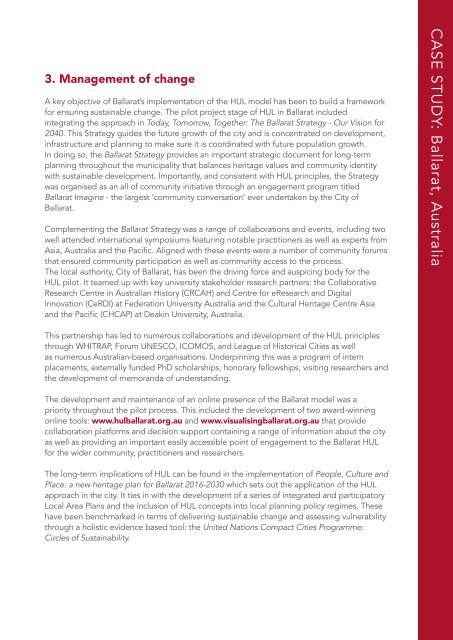GUIDEBOOK
wirey5prpznidqx
wirey5prpznidqx
You also want an ePaper? Increase the reach of your titles
YUMPU automatically turns print PDFs into web optimized ePapers that Google loves.
3. Management of change<br />
A key objective of Ballarat’s implementation of the HUL model has been to build a framework<br />
for ensuring sustainable change. The pilot project stage of HUL in Ballarat included<br />
integrating the approach in Today, Tomorrow, Together: The Ballarat Strategy - Our Vision for<br />
2040. This Strategy guides the future growth of the city and is concentrated on development,<br />
infrastructure and planning to make sure it is coordinated with future population growth.<br />
In doing so, the Ballarat Strategy provides an important strategic document for long-term<br />
planning throughout the municipality that balances heritage values and community identity<br />
with sustainable development. Importantly, and consistent with HUL principles, the Strategy<br />
was organised as an all of community initiative through an engagement program titled<br />
Ballarat Imagine - the largest ‘community conversation’ ever undertaken by the City of<br />
Ballarat.<br />
Complementing the Ballarat Strategy was a range of collaborations and events, including two<br />
well attended international symposiums featuring notable practitioners as well as experts from<br />
Asia, Australia and the Pacific. Aligned with these events were a number of community forums<br />
that ensured community participation as well as community access to the process.<br />
The local authority, City of Ballarat, has been the driving force and auspicing body for the<br />
HUL pilot. It teamed up with key university stakeholder research partners: the Collaborative<br />
Research Centre in Australian History (CRCAH) and Centre for eResearch and Digital<br />
Innovation (CeRDI) at Federation University Australia and the Cultural Heritage Centre Asia<br />
and the Pacific (CHCAP) at Deakin University, Australia.<br />
CASE STUDY: Ballarat, Australia<br />
This partnership has led to numerous collaborations and development of the HUL principles<br />
through WHITRAP, Forum UNESCO, ICOMOS, and League of Historical Cities as well<br />
as numerous Australian-based organisations. Underpinning this was a program of intern<br />
placements, externally funded PhD scholarships, honorary fellowships, visiting researchers and<br />
the development of memoranda of understanding.<br />
The development and maintenance of an online presence of the Ballarat model was a<br />
priority throughout the pilot process. This included the development of two award-winning<br />
online tools: www.hulballarat.org.au and www.visualisingballarat.org.au that provide<br />
collaboration platforms and decision support containing a range of information about the city<br />
as well as providing an important easily accessible point of engagement to the Ballarat HUL<br />
for the wider community, practitioners and researchers.<br />
The long-term implications of HUL can be found in the implementation of People, Culture and<br />
Place: a new heritage plan for Ballarat 2016-2030 which sets out the application of the HUL<br />
approach in the city. It ties in with the development of a series of integrated and participatory<br />
Local Area Plans and the inclusion of HUL concepts into local planning policy regimes. These<br />
have been benchmarked in terms of delivering sustainable change and assessing vulnerability<br />
through a holistic evidence based tool: the United Nations Compact Cities Programme:<br />
Circles of Sustainability.


